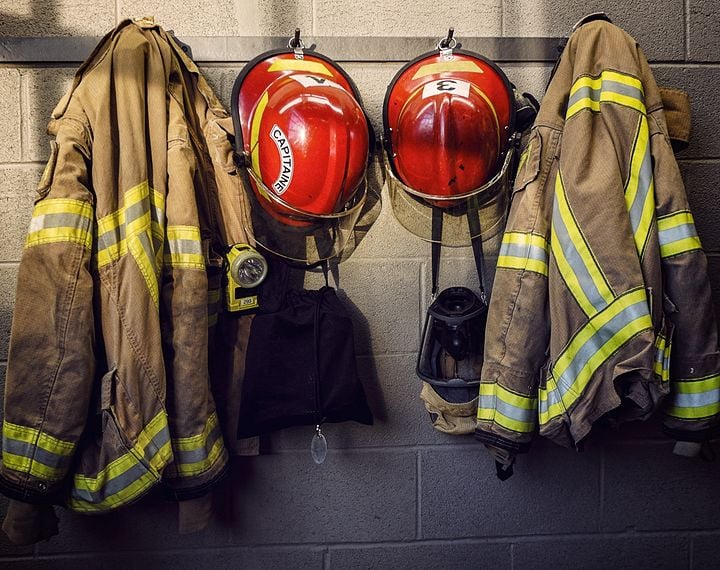Our Protect Wellness First Responder Program
Every day, we rely on frontline workers to keep us safe and well. But many first responders face job-related stresses that take a heavy toll and can even be fatal. Suicide, cancer and heart attack are the top causes of death for first responders. This is unacceptable.
Our Protect Wellness Program arms first responders with the required tools, knowledge, and support to protect their long term health and mitigate risk from the unique occupational exposures they experience.
Our robust interventions address ongoing health risks and educate front line communities from the top down to help to protect first responders across the U.S.

Suicide Kills More Firefighters and Law Enforcement Officers Each Year than Other Line-of-duty Deaths.(1, 2)
5x
PTSD and depression rates among firefighters and police officers have been found to be as much as five times higher than that of the general population.(3)
40%
40% of police officers and firefighters are obese and 80% are overweight.(4) Occupational hazards like stress, sleep disruption, and shift work play a key role.
Firefighters
Firefighters face a 9% increase in cancer diagnoses, and a 14% increase in cancer-related deaths, compared to the U.S. general population.(5)
70%Cancer causes 70% of line-of-duty deaths for firefighters over their entire career.(5) |
#1A heart attack is the #1 killer of on-duty firefighters.(6) |


Law Enforcement
40%40% of law enforcement officers have a sleep disorder, almost double the rate of the general population.(7, 8) |
69xSudden cardiac death accounts for up to 10% of all U.S. on-duty law enforcement deaths. Risk of sudden cardiac death is up to 69X higher during high stress duties.(9) |
Our Approach
The Protect Wellness program was created to combat the cycle of unaddressed trauma, illness, and death by improving the overall health and wellness of first responders nationwide. Given the unique job-related stresses and exposures to trauma, first responders are at high risk for developing PTSD, depression, anxiety, suicidal thoughts and behaviors, sleep disorders, cancer, and cardiovascular disease. It is critical that first responders have access to the education, support, and technology needed to protect their wellbeing, so they can continue to protect us.
We believe that food is medicine. That’s why our Whole Foods Nutritional Reset Module is a foundational part of our program. We teach you how simple choices can have profound effects on inflammation, immune function, and your body’s ability to detox from toxic exposures.
Cardiovascular disease is the leading cause of on-duty death for firefighters and police officers, and more than 70% of first responders are overweight. We combine education with coaching, technology, and cutting-edge advances in the science of health behavior change to facilitate success.
The schedule and demands of your chosen career mean that you will experience disrupted sleep and circadian rhythm. To help mitigate the risks of shift work, we provide you and your team with proactive education, coaching, support, and cutting edge technology to optimize your sleep.
The rate of suicide, PTSD, and depression are much higher for first responders than that of the general population. Our program leverages cutting edge technology, neuroplasticity training, biofeedback, and peer support to help boost resilience and lower the toll from cumulative trauma exposure.
As a first responder, you and your team members routinely put yourselves in harm's way to protect the rest of society. The cumulative toll of stressful experiences builds over time, and research shows a clear connection to heart disease, cancer, brain disorders, suicide, and many other health conditions. We teach you simple and effective techniques to measure and decrease stress across many different spheres of life. With regular practice you will increasingly be able to shift your physiology on demand and function at your peak.
As a first responder, you are an industrial athlete. Your work requires high physical performance from your body, frequently on short notice and with high intensity burst activity. Common injuries include shoulder, neck, back, hips, and knees.
As a firefighter and first responder, you face significant occupational and environmental exposures to carcinogens. We help you decrease your risk of cancer through prevention education and comprehensive lifestyle change. We teach you to identify proven carcinogens, support you in making meaningful changes, and help you live an "anti-cancer" life.
Physical training and movement education must include strength as well as exercises that are restorative and build resilience, in order to perform at your best and avoid dangerous injuries. To facilitate optimal physical performance, we place emphasis on core strengthening, mobility, and workouts that protect your body from costly injuries.
Identified Exposures and Toxins Relevant to the First Responder Industry
Through personalized, collaborative, data-driven insights, the Protect Wellness care team is able to leverage the best health technologies to provide real-time decision-making and optimal care.
-
We believe that food is medicine. That’s why our Whole Foods Nutritional Reset Module is a foundational part of our program. We teach you how simple choices can have profound effects on inflammation, immune function, and your body’s ability to detox from toxic exposures.
-
As a first responder, you and your team members routinely put yourselves in harm's way to protect the rest of society. The cumulative toll of stressful experiences builds over time, and research shows a clear connection to heart disease, cancer, brain disorders, suicide, and many other health conditions. We teach you simple and effective techniques to measure and decrease stress across many different spheres of life. With regular practice you will increasingly be able to shift your physiology on demand and function at your peak.
-
Cardiovascular disease is the leading cause of on-duty death for firefighters and police officers, and more than 70% of first responders are overweight. We combine education with coaching, technology, and cutting-edge advances in the science of health behavior change to facilitate success.
-
As a first responder, you are an industrial athlete. Your work requires high physical performance from your body, frequently on short notice and with high intensity burst activity. Common injuries include shoulder, neck, back, hips, and knees.
-
The schedule and demands of your chosen career mean that you will experience disrupted sleep and circadian rhythm. To help mitigate the risks of shift work, we provide you and your team with proactive education, coaching, support, and cutting edge technology to optimize your sleep.
-
As a firefighter and first responder, you face significant occupational and environmental exposures to carcinogens. We help you decrease your risk of cancer through prevention education and comprehensive lifestyle change. We teach you to identify proven carcinogens, support you in making meaningful changes, and help you live an "anti-cancer" life.
-
The rate of suicide, PTSD, and depression are much higher for first responders than that of the general population. Our program leverages cutting edge technology, neuroplasticity training, biofeedback, and peer support to help boost resilience and lower the toll from cumulative trauma exposure.
-
Physical training and movement education must include strength as well as exercises that are restorative and build resilience, in order to perform at your best and avoid dangerous injuries. To facilitate optimal physical performance, we place emphasis on core strengthening, mobility, and workouts that protect your body from costly injuries.
"I have been in the Fire Service for nearly 30 years. I have witnessed and experienced firsthand the toll that this job takes on firefighter health and wellness and in recent years, we have clearly identified cancer, sudden cardiac death, and suicide as the primary threats to firefighter survival.
I serve as the Training Division Chief, Health and Safety Officer, and Fitness and Wellness Coordinator for the Bellingham Fire Department. The Bellingham Fire Department was honored to participate in the “Protect Wellness Program Pilot Project” that demonstrated the incredible value of a comprehensive wellness program for firefighters.
Data drives decision making in the modern-day fire service, and the Functional Medicine Research and Technology Center is extremely well equipped and positioned to provide data and education that will save lives. I am excited and inspired as I imagine a fire service where our newest members have access to programs, education, community, and interventions that will protect them from the known occupational threats listed above while also helping them to optimize firefighter performance and improve their quality of life away from work."

Results That Speak For Themselves
When we began our wellness program with the Berkeley Fire Department (BFD) in 2016, we had big goals in mind. We wanted to build a program that could be a model for not just the BFD, but for fire departments at large. So, we built our program to:
- Improve physical, emotional, and spiritual resilience.
- Reduce work-comp injuries and the number of sick days.
- Increase mental and physical well-being and performance.
- Reduce the risk of cancer and toxin exposure.
- Improve sleep and minimize the toll of circadian disruption.
- Reduce the risk of cardiovascular disease.
- Reduce the toll of acute and chronic stress, anxiety, and trauma.
- Decrease frequency and incidence of suicide.

With Protect Wellness, Participants Demonstrated
8
Beats per minute (9%) decrease in resting heart rate
22%
Increase in heart rate variability (HRV)
36%
Increase in deep sleep
35%
Decrease in the time it took to fall asleep
28%
Decreased in perceived stress
20%
Decrease in body fat mass in pounds
16%
Decrease in body fat percentage
0.3%
Decrease in hemoglobin A1C
Fire Departments We Have Worked With





-
- Ruderman Family Foundation. (n.d.). Study: police officers and firefighters are more likely to die by suicide than in line of duty. Ruderman Family Foundation. https://rudermanfoundation.org/white_papers/police-officers-and-firefighters-are-more-likely-to-die-by-suicide-than-in-line-of-duty/
- Scott-Smith, B. (2019, April 19). Suicide the leading cause of death for police officers, data show. WSHU Public Radio. https://www.wshu.org/post/suicide-leading-cause-death-police-officers-data-show#stream/0
- National Alliance on Mental Illness. (n.d.). Crisis intervention - law enforcement. National Alliance on Mental Illness. https://www.nami.org/Advocacy/Crisis-Intervention/Law-Enforcement
- Loux, M. (2017, April 7). Tackling the obesity epidemic in law enforcement. Police1. https://www.police1.com/police-products/fitness-health-wellness/articles/tackling-the-obesity-epidemic-in-law-enforcement-Wjww8YOny7DXry6Z/
- Firefighter Cancer Support Network. (n.d.). Explore our resources - FAQ. Firefighter Cancer Support Network. https://firefightercancersupport.org/resources/faq/
- US Fire Administration. (n.d.). Annual report on firefighter fatalities in the United States - 2018. Firefighter Cancer Support Network. https://www.usfa.fema.gov/downloads/pdf/publications/firefighter-fatalities-2018.pdf
- National Institute of Justice. (2009, January 5). Impact of Sleep Deprivation on Police Performance. National Institute of Justice. https://nij.ojp.gov/topics/articles/impact-sleep-deprivation-police-performance#note5
- Rajaratnam, S. M. W., Barger, L. K., Lockley, S. W., et al. (2011). Sleep disorders, health, and safety in police officers. JAMA, 306(23), 2567-2578. https://doi.org/10.1001/jama.2011.1851
- Harvard School of Public Health. (2014, November 18). Police face higher risk of sudden cardiac death during stressful duties. Harvard School of Public Health. https://www.hsph.harvard.edu/news/press-releases/police-face-higher-risk-of-sudden-cardiac-death-during-stressful-duties/
Help us transform lives
Support our Protect Wellness First Responder Program by making a donation today.
First Responders Resources
Sorry!
No items currently match your filtering criteria.





